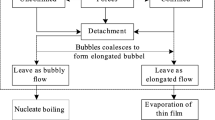Abstract
The study of nanobubbles (with sizes of the order of tens to hundreds of nanometers) is currently a hot spot of cavitation and bubble dynamics. In the literature, classical formulas are widely employed for the predictions of the thermal behavior of oscilla- ting macro-bubbles. However, for modelling nanobubbles, the classical formulas may not be adequate due to the effects of the surface tension. In the present paper, a formula with the effects of surface tension fully considered is proposed for the predictions of thermal behavior. The predictions based on the classical formula are also presented for comparisons to show the advantages of the present formula.
Similar content being viewed by others
References
LOHSE D., ZHANG X. Surface nanobubbles and nanodroplets[J]. Reviews of Modern Physics, 2015, 87(3): 981–1035.
YASUI K., TUZIUTI T. and KANEMATSU W. et al. Advanced dynamic-equilibrium model for a nanobubble and a micropancake on a hydrophobic or hydrophilic surface[J]. Physical Review E, 2015, 91(3): 033008.
DEVIN Jr C. Survey of thermal, radiation, and viscous damping of pulsating air bubbles in water[J]. The Journal of the Acoustical Society of America, 1959, 31(12): 1654–1667.
ZHANG Y. Heat transfer across interfaces of oscillating gas bubbles in liquids under acoustic excitation[J]. International Communications in Heat and Mass Transfer, 2013, 43(2): 1–7.
ZHANG A. M., CUI P. and CUI J.. et al. Experimental study on bubble dynamics subject to buoyancy[J]. Journal of Fluid Mechanics, 2015, 776: 137–160.
ZHANG A. M., LI S. and CUI J. Study on splitting of a toroidal bubble near a rigid boundary[J]. Physics of Fluids, 2015, 27: 062102.
ZHANG A. M., LIU Y. L. Improved three-dimensional bubble dynamics model based on boundary element method[J]. Journal of Computational Physics, 2015, 294: 208–223.
ZHANG Y., QIAN Z. and JI B. et al. A review of microscopic interactions between cavitation bubbles and particles in silt-laden flow[J]. Renewable and Sustainable Energy Reviews, 2016, 56: 303–318.
Author information
Authors and Affiliations
Corresponding author
Additional information
Project supported by the National Natural Science Foun- dation of China (Grant No. 51506051), the Open Research Fund Program of State Key Laboratory of Water Resources and Hydropower Engineering Science, Wuhan University (Grant No. 2014SDG01).
Biography: Yu-ning ZHANG (1983-), Male, Ph. D., Associate Professor
Rights and permissions
About this article
Cite this article
Zhang, Yn., Li, S. Improved formulas for thermal behavior of oscillating nanobubbles. J Hydrodyn 28, 325–328 (2016). https://doi.org/10.1016/S1001-6058(16)60635-2
Received:
Revised:
Published:
Issue Date:
DOI: https://doi.org/10.1016/S1001-6058(16)60635-2




